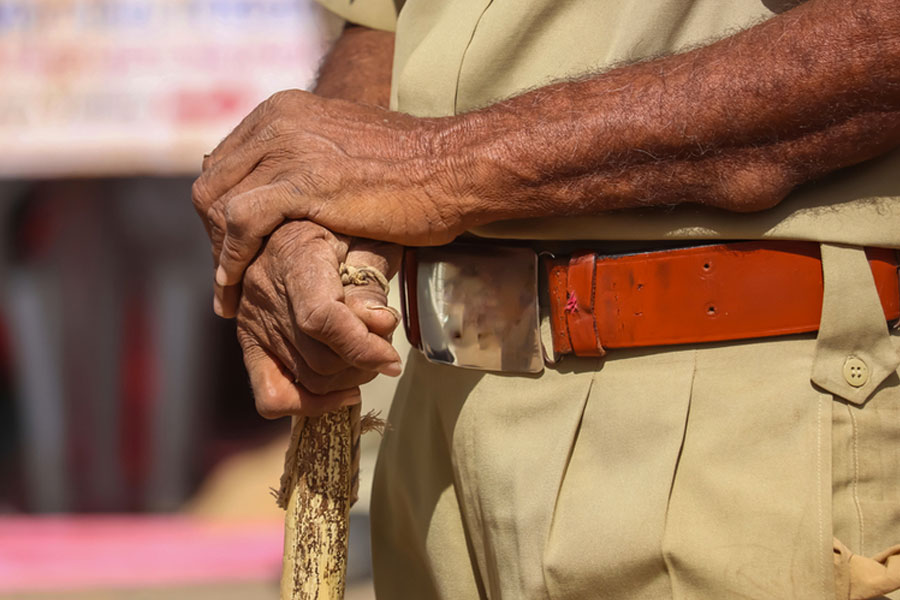 |
| The pagoda as it appears now (picture by Bishwarup Dutta); (below) an old photograph of the Eden Gardens, with the pagoda and surrounding garden (picture by Parimal Goswami) |
It was once the most exotic and colourful sight of Calcutta. Now, the Burmese pagoda at the Eden Gardens is a shabby, crumbling heap.
Intricate wood carvings are liberally strewn around the base, and its soaring, multi-tiered tower — once a brilliant red-and-gold — is overgrown with parasites, creepers and weeds that eat into the roof and run riot around the structure as well. Caged for months inside bamboo scaffolding, this charming monument is a victim of neglect, a common enough malaise in a city sadly unaware of the value and the worth of its built heritage.
The PWD, which is in charge of its upkeep, has plans to renovate it, but the administration’s general apathy towards resolving problems seems to be so deep-seated that one wonders whether this secular shrine would be well maintained thereafter.
Now, however, the pagoda is a picture of decay. Plants have struck root in between the wooden beams and the flamboyant woodwork is covered with moss and bird dropping. Creepers embrace the masonry protectors of the shrine and the monsters at the entrance, which encircle it with their tails. These giant plaster figures, originally white, look weather-beaten and are stained with moss. The two wood figures of the guardians standing by the water body have developed cracks.
When our photographer visited the pagoda on October 9, he found and shot some ornamental woodwork lying on the ground under the pagoda roof. When he returned there on November 2, one of these pieces was missing. According to a highly placed PWD source, the pagoda has its own guard and the piece was in all probability picked up and kept in the camp set up for repair work.
The pagoda was last repaired in 2000, and Manisha Rakshit, who recently retired as chief government architect, PWD, says since the structure was made of Burma teak, logs of identical quality in the government stores gathered from Medical College and “dariya hajat” of the Alipore Central Jail were used when some sections required replacement.
The wood had become discoloured and she had to remove layers to discover the original red-and-gold colour scheme. A skilled Nepalese craftsman from the Darjeeling area, known as Sharmaji, had done the work.
The PWD source said Sharmaji is dead, so a private agency will hire craftsmen from Murshidabad when the actual work begins in about 20 days. Burma teak has been found in the government store, sourced this time from the Jessop Building on Strand Road. These beams were replaced with steel joists when the building was repaired. Some beams from the Bankshall court building have been sent for testing.
The PWD is waiting for funds to flow in as about Rs 12 lakh to Rs 15 lakh will be required for the project. “We have to ensure that this lasts 10 years. So after the paint work is complete, the structure will be coated with a protective layer that will safeguard it from erosion, termites and the weather,” said the source. Although the process began some time ago, the actual work will take about four months.
 |
The garden itself is under the charge of the forest department and is, in general, much better looked after than Curzon Park, opposite Raj Bhavan, which with its heaps of garbage, is the very picture of neglect. The Eden Gardens has a neat enough garden of herbs, and although the shrubs at the stadium-end need thorough trimming, and the stagnant pool adjacent to it has become muddy, the grounds are, in general, well manicured. The grounds are strewn with plastic bottles, but littering, it seems, is the sacred right of all visitors.
The bandstand is there, although garishly coloured, and one was pleasantly surprised that the two fountains — one with cherubs (limned a shade of blue that has, of late, become the official colour of the city, and referred to in jest as Calcutta Blues) and another with a stork — have not been removed.
Readers of a certain age will recall how till the late 1960s people in droves used to visit the garden in the late afternoon to take the soothing evening air. The stretch of Strand Road in front of the garden would be lined with cars then, and the graceful silhouette of the Gowalior Monument, with its cast iron Moghul-style dome, made the sunset look even more pretty. Even the hottest summer days were cooled by the damp breeze rising from the river, and chana-garam sold by Gujarati men in spotless dhotis and caps or an ice cream straight from the cart — of which there were plentiful — would enhance the pleasure of watching the streetlights come to life as darkness descended.
This is a hard fact unsweetened by nostalgia, as the same stretch of road and the pavements have turned into open-air lavatories that stink to high heaven and an ever-expanding idol dump, post-bhasan. During religious festivals, this stretch becomes highly avoidable as buses carrying hordes of pilgrims are parked here and they do their worst out in the open.
The Eden Gardens keeps the oddest hours — noon to 5pm. So, no question of spending an evening there, even if the mosquitoes spare you their love bites.
The gardens have turned into a haunt for lovers and voyeurs, and canoodling couples are a common sight on any given afternoon. Being self-appointed guardians of morality, the administration cannot allow amorous activity after dark. But it can become unsafe here, what with its wealth of coppices, nooks and crannies and the huge water body. It is unsafe for children any time of the day — the playground boasts some damaged and warped equipment for their recreation.
The gardens are associated with the Misses Emily and Fanny Eden, but it was actually their brother, the governor-general, Lord Auckland, who had ordered this pleasure ground, and it was the civil architect, Captain Fitzgerald, who executed this project.
 |
The pagoda was transported piece by piece to the gardens from Prome in Burma or Myanmar as it is known today. Ma Kin, wife of Moung Honon, governor of Prome, got it constructed by Moung Hune and 10 other carpenters in three months’ time. The shrine in the form of a tazaung — a prayer hall or a pavilion — had an idol of Gautama Buddha. According to the British Library, “The tazaung has a multi-tiered roof that becomes smaller as it rises and ends in a spire, an architectural element designating sacred space. Burmese wood carvers are historically renowned for their technical skill and creativity, and the pillars and eaves of the tazaung are encrusted with intricate and flamboyant wood carvings. Among the decorative elements are carved pediments decorated with flaring ornamental elements in the form of haunches of a wild ox known as saing-baung, flame-like finials, mythical birds and spirit figures from Burmese cosmology.”
When Lord Dalhousie visited Prome in 1853, he decided to ship it to Calcutta, the second city of the Empire then. It arrived here on September 29, 1854, and was stored in Fort William before a suitable site could be found for it.
It was set up in the gardens over three months — October, November and December 1856 — by a dozen Burmese artisans. A fading plaque by the pagoda testifies to this.
Which other heritage Calcutta landmark would you want Metro to revisit? Tell ttmetro@abpmail.com









